Zheng-Hua Tan
Aalborg University
Exploring Resolution-Wise Shared Attention in Hybrid Mamba-U-Nets for Improved Cross-Corpus Speech Enhancement
Oct 02, 2025Abstract:Recent advances in speech enhancement have shown that models combining Mamba and attention mechanisms yield superior cross-corpus generalization performance. At the same time, integrating Mamba in a U-Net structure has yielded state-of-the-art enhancement performance, while reducing both model size and computational complexity. Inspired by these insights, we propose RWSA-MambaUNet, a novel and efficient hybrid model combining Mamba and multi-head attention in a U-Net structure for improved cross-corpus performance. Resolution-wise shared attention (RWSA) refers to layerwise attention-sharing across corresponding time- and frequency resolutions. Our best-performing RWSA-MambaUNet model achieves state-of-the-art generalization performance on two out-of-domain test sets. Notably, our smallest model surpasses all baselines on the out-of-domain DNS 2020 test set in terms of PESQ, SSNR, and ESTOI, and on the out-of-domain EARS-WHAM_v2 test set in terms of SSNR, ESTOI, and SI-SDR, while using less than half the model parameters and a fraction of the FLOPs.
DSpAST: Disentangled Representations for Spatial Audio Reasoning with Large Language Models
Sep 17, 2025Abstract:Reasoning about spatial audio with large language models requires a spatial audio encoder as an acoustic front-end to obtain audio embeddings for further processing. Such an encoder needs to capture all information required to detect the type of sound events, as well as the direction and distance of their corresponding sources. Accomplishing this with a single audio encoder is demanding as the information required for each of these tasks is mostly independent of each other. As a result, the performance obtained with a single encoder is often worse than when using task-specific audio encoders. In this work, we present DSpAST, a novel audio encoder based on SpatialAST that learns disentangled representations of spatial audio while having only 0.2% additional parameters. Experiments on SpatialSoundQA with the spatial audio reasoning system BAT demonstrate that DSpAST significantly outperforms SpatialAST.
Learning Robust Spatial Representations from Binaural Audio through Feature Distillation
Aug 28, 2025Abstract:Recently, deep representation learning has shown strong performance in multiple audio tasks. However, its use for learning spatial representations from multichannel audio is underexplored. We investigate the use of a pretraining stage based on feature distillation to learn a robust spatial representation of binaural speech without the need for data labels. In this framework, spatial features are computed from clean binaural speech samples to form prediction labels. These clean features are then predicted from corresponding augmented speech using a neural network. After pretraining, we throw away the spatial feature predictor and use the learned encoder weights to initialize a DoA estimation model which we fine-tune for DoA estimation. Our experiments demonstrate that the pretrained models show improved performance in noisy and reverberant environments after fine-tuning for direction-of-arrival estimation, when compared to fully supervised models and classic signal processing methods.
MambAttention: Mamba with Multi-Head Attention for Generalizable Single-Channel Speech Enhancement
Jul 01, 2025



Abstract:With the advent of new sequence models like Mamba and xLSTM, several studies have shown that these models match or outperform state-of-the-art models in single-channel speech enhancement, automatic speech recognition, and self-supervised audio representation learning. However, prior research has demonstrated that sequence models like LSTM and Mamba tend to overfit to the training set. To address this issue, previous works have shown that adding self-attention to LSTMs substantially improves generalization performance for single-channel speech enhancement. Nevertheless, neither the concept of hybrid Mamba and time-frequency attention models nor their generalization performance have been explored for speech enhancement. In this paper, we propose a novel hybrid architecture, MambAttention, which combines Mamba and shared time- and frequency-multi-head attention modules for generalizable single-channel speech enhancement. To train our model, we introduce VoiceBank+Demand Extended (VB-DemandEx), a dataset inspired by VoiceBank+Demand but with more challenging noise types and lower signal-to-noise ratios. Trained on VB-DemandEx, our proposed MambAttention model significantly outperforms existing state-of-the-art LSTM-, xLSTM-, Mamba-, and Conformer-based systems of similar complexity across all reported metrics on two out-of-domain datasets: DNS 2020 and EARS-WHAM_v2, while matching their performance on the in-domain dataset VB-DemandEx. Ablation studies highlight the role of weight sharing between the time- and frequency-multi-head attention modules for generalization performance. Finally, we explore integrating the shared time- and frequency-multi-head attention modules with LSTM and xLSTM, which yields a notable performance improvement on the out-of-domain datasets. However, our MambAttention model remains superior on both out-of-domain datasets across all reported evaluation metrics.
A Survey of Deep Learning for Complex Speech Spectrograms
May 13, 2025Abstract:Recent advancements in deep learning have significantly impacted the field of speech signal processing, particularly in the analysis and manipulation of complex spectrograms. This survey provides a comprehensive overview of the state-of-the-art techniques leveraging deep neural networks for processing complex spectrograms, which encapsulate both magnitude and phase information. We begin by introducing complex spectrograms and their associated features for various speech processing tasks. Next, we explore the key components and architectures of complex-valued neural networks, which are specifically designed to handle complex-valued data and have been applied for complex spectrogram processing. We then discuss various training strategies and loss functions tailored for training neural networks to process and model complex spectrograms. The survey further examines key applications, including phase retrieval, speech enhancement, and speech separation, where deep learning has achieved significant progress by leveraging complex spectrograms or their derived feature representations. Additionally, we examine the intersection of complex spectrograms with generative models. This survey aims to serve as a valuable resource for researchers and practitioners in the field of speech signal processing and complex-valued neural networks.
Handling Domain Shifts for Anomalous Sound Detection: A Review of DCASE-Related Work
Mar 13, 2025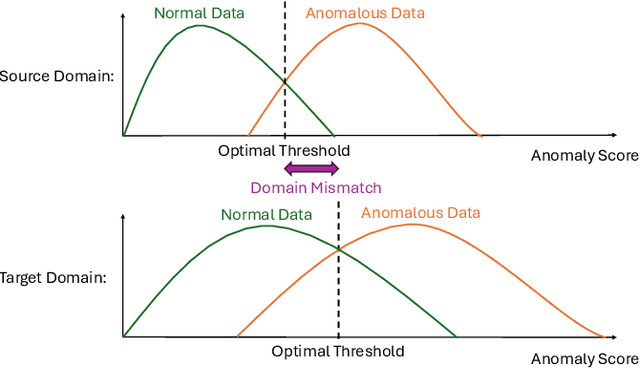

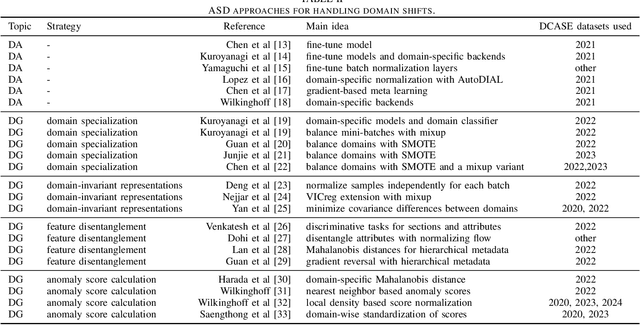
Abstract:When detecting anomalous sounds in complex environments, one of the main difficulties is that trained models must be sensitive to subtle differences in monitored target signals, while many practical applications also require them to be insensitive to changes in acoustic domains. Examples of such domain shifts include changing the type of microphone or the location of acoustic sensors, which can have a much stronger impact on the acoustic signal than subtle anomalies themselves. Moreover, users typically aim to train a model only on source domain data, which they may have a relatively large collection of, and they hope that such a trained model will be able to generalize well to an unseen target domain by providing only a minimal number of samples to characterize the acoustic signals in that domain. In this work, we review and discuss recent publications focusing on this domain generalization problem for anomalous sound detection in the context of the DCASE challenges on acoustic machine condition monitoring.
xLSTM-SENet: xLSTM for Single-Channel Speech Enhancement
Jan 10, 2025



Abstract:While attention-based architectures, such as Conformers, excel in speech enhancement, they face challenges such as scalability with respect to input sequence length. In contrast, the recently proposed Extended Long Short-Term Memory (xLSTM) architecture offers linear scalability. However, xLSTM-based models remain unexplored for speech enhancement. This paper introduces xLSTM-SENet, the first xLSTM-based single-channel speech enhancement system. A comparative analysis reveals that xLSTM-and notably, even LSTM-can match or outperform state-of-the-art Mamba- and Conformer-based systems across various model sizes in speech enhancement on the VoiceBank+Demand dataset. Through ablation studies, we identify key architectural design choices such as exponential gating and bidirectionality contributing to its effectiveness. Our best xLSTM-based model, xLSTM-SENet2, outperforms state-of-the-art Mamba- and Conformer-based systems on the Voicebank+DEMAND dataset.
Vocal Tract Length Warped Features for Spoken Keyword Spotting
Jan 07, 2025Abstract:In this paper, we propose several methods that incorporate vocal tract length (VTL) warped features for spoken keyword spotting (KWS). The first method, VTL-independent KWS, involves training a single deep neural network (DNN) that utilizes VTL features with various warping factors. During training, a specific VTL feature is randomly selected per epoch, allowing the exploration of VTL variations. During testing, the VTL features with different warping factors of a test utterance are scored against the DNN and combined with equal weight. In the second method scores the conventional features of a test utterance (without VTL warping) against the DNN. The third method, VTL-concatenation KWS, concatenates VTL warped features to form high-dimensional features for KWS. Evaluations carried out on the English Google Command dataset demonstrate that the proposed methods improve the accuracy of KWS.
Noise-Robust Target-Speaker Voice Activity Detection Through Self-Supervised Pretraining
Jan 06, 2025



Abstract:Target-Speaker Voice Activity Detection (TS-VAD) is the task of detecting the presence of speech from a known target-speaker in an audio frame. Recently, deep neural network-based models have shown good performance in this task. However, training these models requires extensive labelled data, which is costly and time-consuming to obtain, particularly if generalization to unseen environments is crucial. To mitigate this, we propose a causal, Self-Supervised Learning (SSL) pretraining framework, called Denoising Autoregressive Predictive Coding (DN-APC), to enhance TS-VAD performance in noisy conditions. We also explore various speaker conditioning methods and evaluate their performance under different noisy conditions. Our experiments show that DN-APC improves performance in noisy conditions, with a general improvement of approx. 2% in both seen and unseen noise. Additionally, we find that FiLM conditioning provides the best overall performance. Representation analysis via tSNE plots reveals robust initial representations of speech and non-speech from pretraining. This underscores the effectiveness of SSL pretraining in improving the robustness and performance of TS-VAD models in noisy environments.
BiSSL: Bilevel Optimization for Self-Supervised Pre-Training and Fine-Tuning
Oct 03, 2024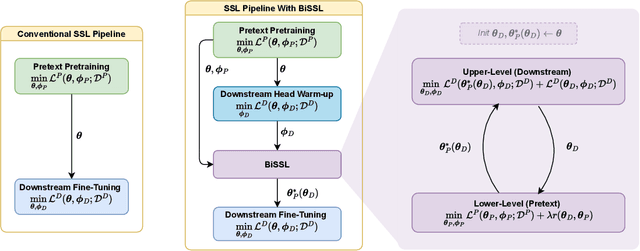

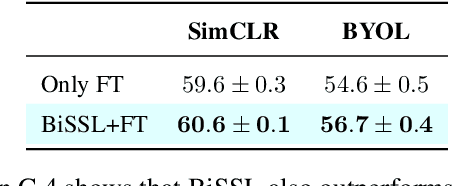
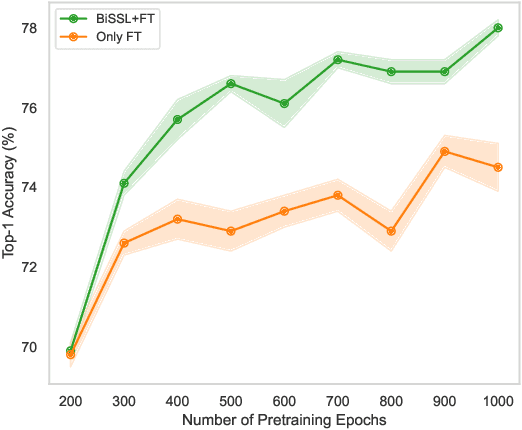
Abstract:In this work, we present BiSSL, a first-of-its-kind training framework that introduces bilevel optimization to enhance the alignment between the pretext pre-training and downstream fine-tuning stages in self-supervised learning. BiSSL formulates the pretext and downstream task objectives as the lower- and upper-level objectives in a bilevel optimization problem and serves as an intermediate training stage within the self-supervised learning pipeline. By more explicitly modeling the interdependence of these training stages, BiSSL facilitates enhanced information sharing between them, ultimately leading to a backbone parameter initialization that is better suited for the downstream task. We propose a training algorithm that alternates between optimizing the two objectives defined in BiSSL. Using a ResNet-18 backbone pre-trained with SimCLR on the STL10 dataset, we demonstrate that our proposed framework consistently achieves improved or competitive classification accuracies across various downstream image classification datasets compared to the conventional self-supervised learning pipeline. Qualitative analyses of the backbone features further suggest that BiSSL enhances the alignment of downstream features in the backbone prior to fine-tuning.
 Add to Chrome
Add to Chrome Add to Firefox
Add to Firefox Add to Edge
Add to Edge